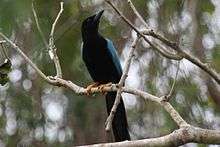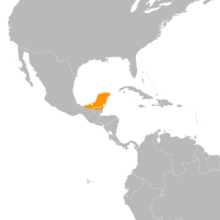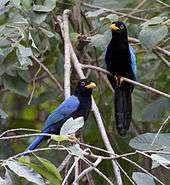Yucatan jay
The Yucatan jay (Cyanocorax yucatanicus) is a species of bird in the family Corvidae, the crows and their allies. It is native to the Yucatán Peninsula where its habitats are subtropical or tropical dry forest, plantations and cleared areas at altitudes up to 250 m (820 ft). Adults are about 30 cm (12 in) long, black, with blue wings, mantle, and tail, black bills, yellow eye rings and legs. Immature birds have yellow bills. This is a common species of jay with a wide range and the International Union for Conservation of Nature has rated its conservation status as being of "least concern".
| Yucatan jay | |
|---|---|
 | |
| Adult in Mexico | |
| Scientific classification | |
| Kingdom: | Animalia |
| Phylum: | Chordata |
| Class: | Aves |
| Order: | Passeriformes |
| Family: | Corvidae |
| Genus: | Cyanocorax |
| Species: | C. yucatanicus |
| Binomial name | |
| Cyanocorax yucatanicus (Dubois, 1875) | |
 | |
Range and habitat
It is found primarily in the Yucatán Peninsula, which comprises the northern part of the nation of Belize; and Guatemala's northern El Petén Department and the Mexican states of Yucatán, Quintana Roo and Campeche. It is also present in parts of the neighbouring states of Chiapas and Tabasco.[1] Its natural habitats are subtropical or tropical dry forests, heavily degraded former forest, and plantations up to 250 m (820 ft).[2]
Description
The jay is approximately 30 cm (12 in) long. Adults are black, with cerulean blue wings, mantle, and tail. They have black bills, yellow eye rings, and yellow legs. Juvenile Yucatán jays have completely yellow bare parts and white, rather than black, body plumage. They molt out of the white plumage by September or October, but retain the yellow bill and eye ring for a few more months. They also have pale-tipped rectrices, which the adults lack.

Status
The Yucatan jay is a common species throughout most of its wide range. It is an adaptable species and the population is thought to be increasing as clearing of forests is creating new areas of suitable habitat. No particular threats have been identified, and the International Union for Conservation of Nature has rated its conservation status as being of "least concern".[1]
References
- BirdLife International (2012). "Cyanocorax yucatanicus". IUCN Red List of Threatened Species. 2012. Retrieved 26 November 2013.CS1 maint: ref=harv (link)
- Van Perlo, Ber (2006). Birds of Mexico and Central America. Princeton University Press. p. plate 71.13. ISBN 978-0-691-12070-6.
External links
| Wikimedia Commons has media related to Cyanocorax yucatanicus. |
| Wikispecies has information related to Cyanocorax yucatanicus |
- "Yucatan jay media". Internet Bird Collection.
- Yucatan jay photo gallery at VIREO (Drexel University)
- Yucatan jay article and photos at mangoverde.com
- Photo; Article world.std.com–"Mexican Birds: Villahermosa and Palenque" Photo-2
- Yucatan jay species account at Neotropical Birds (Cornell Lab of Ornithology)
- Interactive range map of Cyanocorax yucatanicus at IUCN Red List maps
